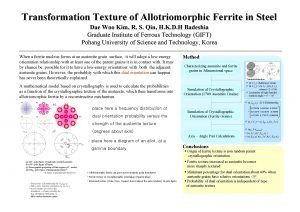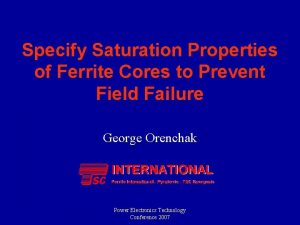Transformation Texture of Allotriomorphic Ferrite in Steel Dae

- Slides: 1

Transformation Texture of Allotriomorphic Ferrite in Steel Dae Woo Kim, R. S. Qin, H. K. D. H Badeshia Graduate Institute of Ferrous Technology (GIFT) Pohang University of Science and Technology, Korea When a ferrite nucleus forms at an austenite grain surface, it will adopt a low-energy orientation relationship with at least one of the parent grains it is in contact with. It may by chance be possible for it to have a low-energy orientation with both the adjacent austenite grains. However, the probablity with which this dual orientation can happen has never been theoretically explained. A mathematical model based on crystallography is used to calculate the probabilities as a function of the crystallographic texture of the austenite, which then transforms into allotriomorphic ferrite by a reconstructive mechanism. (a) Characterizing austenite and ferrite grains in 3 dimensional space Tetrakaidekahedron Simulation of Crystallographic Orientation (1700 Austenite Grains) ü (S J γ 1) : Reference Grain ü (S J γ i) = (S J γ 1)(G 1 J γ i) , where i=2~1700 ü Limitation of right handed rotation angle = 0˚ ~ 45 ˚ ü (αi JKS γ 1) : K-S Relationship (b) place here a frequency distribution of (c) Method dual orientation probability versus the (d) 0. 579356 0. 542586 0. 102537 Simulation of Crystallographic Orientation (Ferrite Grains) = 0. 014470 0. 133650 -0. 78898 -0. 55200 0. 572979 0. 086936 ü (αi J γ’ 1) = (αi JKS γ 1)(γ i J γ 1) strength of the austenite texture (degrees about axis) Axis – Angle Pair Calculations ü (αKS J αrandom) = (αi J γ’ 1)(γ’i JKS αi ) = (αi JKS γi) )(γ i J γ’i)(γ’i JKS αi) place here a diagram of an allot. at a gamma boundary (a) 100 - pole figure of randomly oriented austenite (b) 100 - pole figure of ferrite (c) Stereographic projection of Bain regions (11˚ circles) (d) 100 bcc pole figure of intragranular ferrite * * R. Uemori, Scripta Materialia 48(2003) 371 § Origin of ferrite texture is non random parent crystallographic orientation § Ferrite texture increased as austenite becomes more sharply textured • Allotriomorphic ferrite can grow across austenite grain boundaries • Ferrite texture on crystallographic orientation of parent phase • Blue points : KS relationship by (αi JKS γi) • Pink points : Random orientation by (αi J γ’i) • Some variants are close to KS orientation → Some possibility for dual orientation relationship in fully random austenite matrix Conclusions • Interested texture (Cube, Goss, Copper) shows almost the same tendency in pole figure § Minimum percentage for dual orientation about 40% when austenite grains have relative orientations <5° § Probability of dual orientation is independent of type of austenite texture

